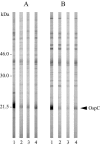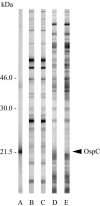Borreliacidal OspC antibodies specific for a highly conserved epitope are immunodominant in human lyme disease and do not occur in mice or hamsters
- PMID: 15939749
- PMCID: PMC1151971
- DOI: 10.1128/CDLI.12.6.746-751.2005
Borreliacidal OspC antibodies specific for a highly conserved epitope are immunodominant in human lyme disease and do not occur in mice or hamsters
Erratum in
- Clin Diagn Lab Immunol. 2005 Sep;12(9):1139
Abstract
Humans produce highly specific borreliacidal antibodies against outer surface protein C (OspC) shortly after infection with Borrelia burgdorferi sensu stricto. We previously demonstrated the epitope recognized by immunoglobulin M (IgM) and IgG OspC borreliacidal antibodies was located within the 50 amino acids nearest the carboxy (C) terminus. In this study, we show the immunodominant epitope is located in the highly conserved region within the seven C-terminal amino acids. Six early Lyme disease sera that contained borreliacidal activity and IgM and/or IgG OspC antibodies were chosen randomly and adsorbed with truncated OspC containing the 16 or 7 amino acids nearest the C terminus. Adsorptions with each truncated protein abrogated the borreliacidal activity completely. In addition, only small concentrations of OspC antibodies remained detectable by enzyme-linked immunosorbent assay and Western blotting. Moreover, borreliacidal OspC antibodies were not induced in laboratory mice or hamsters despite heavy infections with B. burgdorferi spirochetes. These findings confirm that borreliacidal antibodies comprise the majority of the IgM and IgG OspC antibody response in human Lyme disease and that the epitope is located in the highly conserved C terminus. In addition, rodent animal models appear to be inappropriate subjects for assessing the effectiveness of the epitope for serodiagnosis or as a human Lyme disease vaccine.
Figures


Similar articles
-
C-terminal region of outer surface protein C binds borreliacidal antibodies in sera from patients with Lyme disease.Clin Diagn Lab Immunol. 2003 Jul;10(4):573-8. doi: 10.1128/cdli.10.4.573-578.2003. Clin Diagn Lab Immunol. 2003. PMID: 12853388 Free PMC article.
-
Characterization of a unique borreliacidal epitope on the outer surface protein C of Borrelia burgdorferi.FEMS Immunol Med Microbiol. 2006 Oct;48(1):64-74. doi: 10.1111/j.1574-695X.2006.00122.x. FEMS Immunol Med Microbiol. 2006. PMID: 16965353
-
T helper cell priming of mice to Borrelia burgdorferi OspA leads to induction of protective antibodies following experimental but not tick-borne infection.Eur J Immunol. 1997 Nov;27(11):2942-7. doi: 10.1002/eji.1830271129. Eur J Immunol. 1997. PMID: 9394822
-
Development of hepatitis B virus capsids into a whole-chain protein antigen display platform: new particulate Lyme disease vaccines.Int J Med Microbiol. 2008 Jan;298(1-2):135-42. doi: 10.1016/j.ijmm.2007.08.002. Epub 2007 Sep 20. Int J Med Microbiol. 2008. PMID: 17888729 Review.
-
A recombinant vaccine for Lyme disease.Behring Inst Mitt. 1994 Dec;(95):106-8. Behring Inst Mitt. 1994. PMID: 7755503 Review.
Cited by
-
Inferring epitopes of a polymorphic antigen amidst broadly cross-reactive antibodies using protein microarrays: a study of OspC proteins of Borrelia burgdorferi.PLoS One. 2013 Jun 24;8(6):e67445. doi: 10.1371/journal.pone.0067445. Print 2013. PLoS One. 2013. PMID: 23826301 Free PMC article.
-
Enhanced Protective Immunogenicity of Homodimeric Borrelia burgdorferi Outer Surface Protein C.Clin Vaccine Immunol. 2017 Jan 5;24(1):e00306-16. doi: 10.1128/CVI.00306-16. Print 2017 Jan. Clin Vaccine Immunol. 2017. PMID: 27733423 Free PMC article.
-
Development and optimization of OspC chimeritope vaccinogens for Lyme disease.Vaccine. 2020 Feb 18;38(8):1915-1924. doi: 10.1016/j.vaccine.2020.01.027. Epub 2020 Jan 17. Vaccine. 2020. PMID: 31959423 Free PMC article.
-
The Position of His-Tag in Recombinant OspC and Application of Various Adjuvants Affects the Intensity and Quality of Specific Antibody Response after Immunization of Experimental Mice.PLoS One. 2016 Feb 5;11(2):e0148497. doi: 10.1371/journal.pone.0148497. eCollection 2016. PLoS One. 2016. PMID: 26848589 Free PMC article.
-
Epitope mapping of Borrelia burgdorferi OspC protein in homodimeric fold.Protein Sci. 2017 Apr;26(4):796-806. doi: 10.1002/pro.3125. Epub 2017 Feb 11. Protein Sci. 2017. PMID: 28142214 Free PMC article.
References
-
- Altschul, S. F., W. Gish, W. Miller, E. W. Myers, and D. J. Lipman. 1990. Basic local alignment search tool. J. Mol. Biol. 215:403-410. - PubMed
Publication types
MeSH terms
Substances
LinkOut - more resources
Full Text Sources
Other Literature Sources
Medical
Molecular Biology Databases

